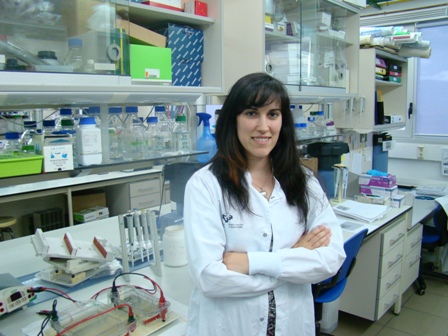Although intervening a priori in a single gene or protein responsible for a disease appears straightforward, it is not. Such is the case of the huntingtin protein, the mutation of which causes Huntington's disease, which is incurable and for which there is little by way of treatment. To start with, the exact function of huntingtin is not known although it is thought to play a role in many cell processes and is essential in the development of the central nervous system. In fact, the silencing of the gene (to stop huntingtin appearing) is incompatible with life and nowadays specifically preventing the expression of mutated huntingtin is a major challenge. That is why other therapeutic strategies include the possibility of halting the progression or delaying the onset of the disease. In this context the researcher Leire Valcárcel of the UPV/EHU's Department of Genetics, Physical Anthropology and Animal Physiology has conducted a study into the factors that could modify the age of onset of the disease, in order to act on them and thus be able to delay and even prevent the disease from manifesting itself.
Further progress in Huntington's disease
A researcher at the UPV/EHU-University of the Basque Country has identified potential modifying factors in the age of onset of Huntington's disease
- Research
First publication date: 22/04/2015

Also known as Huntington's Chorea or the Saint Vitus Dance, Huntington's Disease is described as a rare, genetic, hereditary neurodegenerative disorder with delayed onset. Since 1993, this serious disease has been known to be caused by a single mutation, the CAG (cytosine-adenine-guanine) repeat expansion, in which the HTT gene encodes the protein known as huntingtin. As a result, mutated huntingtin, which is incapable of performing the functions of the protein itself, forms protein aggregates that lead to neuron death. The mutation can be inherited and expresses a dominant pattern, which means the vast majority of patients with Huntington's disease are children of people affected, as the offspring of one affected parent will have a 50% chance of inheriting the disease. This, added to the fact that the disease manifests itself between the ages of 45 and 55 once the reproductive age is over, causes the disease to be perpetuated in families for generations. It is estimated that approximately 1 in every 10,000 inhabitants of European origin suffers from this disease, which can strike both men and women without distinction.
The work of the UPV/EHU has focussed on the study of potential modifying factors of the age of onset of Huntington's disease in order to expand the knowledge about these factors that could function as potential therapeutic targets in order to delay the age of onset of the disease.
Results on a scientific and hospital level
"We conducted an association study between the age of onset, the number of CAG repeat lengths and selected modifying factors. To do this we analysed the CAG repeat length of each patient and selected and analysed 117 polymorphisms or genetic variants in 20 genes, some of which are already linked to the disorder. We also included variables relating to lifestyle, which until now have hardly been explored at all with respect to their link to the age of onset of this disease, include smoking or alcohol misuse," explained the researcher Leire Valcárcel.
"Thanks to this study we have identified a new gene that had never previously been linked to this disease, let alone with its age of onset. But what is even more important, the results obtained from the mRNA(messenger RNA)expression analysis of the gene have provided us with information on its possible mechanism of action," said Valcárcel. "The evidence obtained also suggests that the control over factors relating to lifestyle could delay the appearance of Huntington's symptoms by an average of 5 years," she added. The scientific community is planning to intervene in these genes or factors, either to cure the disease or to delay the onset of it as far as possible.
The results of the study have not only produced significant results on a scientific level, but on a hospital level, too, they have led to the setting up of a patient register and an action protocol has been established to tackle the genetic and clinical diagnosis of the patients.
"It is difficult to predict which therapeutic strategy will end up being developed first and which will be the more effective, but what is certain is that the scientific community has become aware of the need to go on carrying out research into this disease and that many scientists worldwide are striving so that in the future there will be an effective therapy to cure or help these patients," concluded Valcárcel.
Additional information
Leire Valcárcel-Ocete (Barakaldo, Basque Country, 1981) conducted this study as part of her PhD thesis, entitled Factores candidatos a modificar la edad de inicio de la enfermedad de Huntington (Candidate factors modifying age of onset of Huntington's disease). The research was carried out in the Department of Genetics, Physical Anthropology and Animal Physiology of the Faculty of Science and Technology and was supervised by the lecturer Ana Aguirre-Escobal. The work had the collaboration of consultants at the Hospitals of Basurto, Cruces, Galdakao, Txagorritxu and Santiago Apóstol, who, coordinated by BIOEF, gathered clinical data and blood samples of Huntington's patients living in Bizkaia and Araba-Alava. The number of patients who participated in the study was increased thanks to the collaboration of the EHDN, the European Huntington's Disease Network, which provided clinical data and DNA of 285 patients with Huntington's symptoms from 14 European Countries. This network, which brings together most of the European researchers of Huntington's, also provided them with data on patient lifestyle for over 900 people with Huntington's disease.







